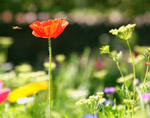How to mow a meadow
The Country Life guide to growing, and mowing, wildflower meadows


When William Robinson published The Wild Garden in 1870, he described his ideas for naturalising plants in almost any situation in the garden. Fifteen years later, he purchased Gravetye Manor and set about putting these ideas into practice. Nearly 130 years later, the wild garden he created is still alive and well at the manor, and among its most enduring aspects are his wildflower meadows.
They are so effective running through the garden, contrasting with the formal architecture and linking views to the countryside beyond. Exploring a meadow from within, on mown paths, is one of the nicest ways of enjoying its details and atmosphere, but our six-acre meadow, the biggest, is also an arresting sight when viewed from a distance. Watching its enormous sweep of wild-flowers change with the season is one of the greatest joys of working in this beautiful place.
The meadow's flowering starts in February with snowdrops and crocuses in a tapestry through the short grass. These give way to hundreds of thousands of Lent lilies, Narcissus pseudonarcissus, which Robinson originally naturalised here all those years ago and now self-sow throughout the site. They flower through a carpet of sky-blue Scilla siberica, making a glorious combination right through the spring.
When they finish, bluebells take over, accompanied by the lilac Anemone nemorosa Robinson-iana and native pink cuckoo flower Cardamine pratensis. Then, the meadow erupts in its full glory in June, with ox-eye daisies, buttercups and thousands of common spotted orchids. As they fade away, the meadow turns golden as it goes to seed, given depth by the purple sheen of knapweed flowers, which finish the show at summer's end. This is when large flocks of finches arrive, fluttering through the meadow, feeding on the seed, and the meadow is alive with moths, spiders and the song of crickets.
* Subscribe to Country Life; Country Life on Ipad
Most farmers cut their meadows much earlier than we do ours, because they need to harvest the grass when it has optimum nutritional value. But we manage our meadow for the value of its wildflowers and so wait until we're sure everything has set seed for next year. I watch the seed heads of the common spotted orchid as an indicator, so when they're ripe and the weather is dry, we're ready to cutusually around mid August.
In our big meadow, the local farmer can get in with his tractor and hay-making equipment and he takes the grass to feed his cattle. But in our smaller meadows, we have to use a pedestrian-operated mechanical scythe and a rake. It's so important that all of the grass is removed. If left on the meadow to break down, it will act like a mulch, preventing the wildflower seeds germinating, and will enrich the soil, resulting in thicker grass growth and less floral diversity the following year.
Sign up for the Country Life Newsletter
Exquisite houses, the beauty of Nature, and how to get the most from your life, straight to your inbox.
Soon after the meadow's annual cut, it gives us one last show before winter, with a mass of autumn crocus. Throughout the winter, it's important to keep the grass low, to reduce its vigour, so that, in spring, bulbs aren't swamped by too thick a sward. Mowing as low as possible, with a collecting box, through the winter does a good job, when the weather permits it. In our large meadow, however, we've found that a small flock of sheep does a much better job, as well looking quite beautiful on the landscape.
Meadows in gardens can make beautiful and gratifying features, with a long season of interest in return for relatively little work. However, the most important point is that, since the 1930s, the UK has lost 98% of its species-rich meadows. Fields are now fertilised and cut early as part of an efficient agricultural system, which has had to adapt over the past 50 years to feed the population. Now, fragments of these habitats are all that remain and garden meadows make up an important part of these fragments.
In the future, we hope to start harvesting the seed from our meadow after it's cut. This can then be used to enrich and create other meadows and do a little to restore some of these beautiful and important habitats.
* Follow Country Life magazine on Twitter
Tom Coward is head gardener at Gravetye Manor, West Sussex (www.gravetyemanor.co.uk)
Country Life is unlike any other magazine: the only glossy weekly on the newsstand and the only magazine that has been guest-edited by HRH The King not once, but twice. It is a celebration of modern rural life and all its diverse joys and pleasures — that was first published in Queen Victoria's Diamond Jubilee year. Our eclectic mixture of witty and informative content — from the most up-to-date property news and commentary and a coveted glimpse inside some of the UK's best houses and gardens, to gardening, the arts and interior design, written by experts in their field — still cannot be found in print or online, anywhere else.
-
 Six rural properties with space, charm and endless views, as seen in Country Life
Six rural properties with space, charm and endless views, as seen in Country LifeWe take a look at some of the best houses to come to the market via Country Life in the past week.
By Toby Keel
-
 Exploring the countryside is essential for our wellbeing, but Right to Roam is going backwards
Exploring the countryside is essential for our wellbeing, but Right to Roam is going backwardsCampaigners in England often point to Scotland as an example of how brilliantly Right to Roam works, but it's not all it's cracked up to be, says Patrick Galbraith.
By Patrick Galbraith